


 |
 |
 |
| Walnut Springs Church | |
| Collected by Monty R. Loving, 2005 | |
Many communities are built around a church. Churches provided a place of worship and also a place for communities to come together socially. They were places where adults spoke about the weather, the crops and each other and a place where kids gathered to play all the games kids play. Probably, no community was more centered around its church and school house than Oranda.
The records of Walnut Springs congregation have been kept in three separate books. The first book covered the period from about 1808, the year after Thomas Campbell settled in Washington County, Pennsylvania, until March 24, 1820. The second book extends from 1820 until August 22, 1875. The third book which is our present record extends from 1875 until the present time. The first church book seems to be entirely lost, so the only account we have of Walnut Springs congregation prior to March 24, 1820, is a synopsis of the first church book written by Abram Stickley and headed, "Remarks". I quote those "Remarks" as follows:
"In the year of our Lord 1808 a few persons at Strasburg, Shenandoah County, in the state of Virginia met as members of the Church of Christ, taking the name of Christian and agreeing to have no rule of faith and practice other than the Bible. The first teaching received was a few visits from Jonathan Foster and Joseph Sidebottom, who were formerly Methodists and were not altogether clear of creeds, catechisms, confessions of faith and traditions of men. Their services were acceptable but a short time. About this time Thomas Reeves and Thomas Morris from Eastern Virginia visited the church.
"In the year 1809 Frederick Plummer visited the church and was well received. He was the first who asserted among us and maintained that neither sprinkling nor pouring was the one baptism mentioned in the Scriptures, and though he met with some opposition, many by searching the scriptures were convinced of the truth and were baptized. About the same time William Lamphier of Alexandria visited us and also James Lockhart from old Virginia.
"In 1810 we were visited by John Mavity from Kentucky. He was highly esteemed for his work's sake."These names are unfamiliar because these were not preachers of the early Restoration movement, but most of them were ministers in the Old Christian church of Christian connection. Brother Abram Stickley continues, "During this time, our meetings were held at William Smith's, Zachariah Wilson's, and Daniel Boehm's and in Strasburg.
"In the year 1812 Robert T. Ferguson in the twenty- second year of his age came among us and was well received. About this time Elias Smith from New England visited us and abode a few days preaching to large congregations. In September 1821 Brother R.T. Ferguson brought his family to Shenandoah." I will say just here that the house which R.T. Ferguson built and in which he lived until he removed to Baltimore in April 1846, and in which he taught school for a number of years in connection with his preaching still stands on Mulberry Run near Capon Grade about two miles from here and is now occupied by Robert Kaufflet.
Brother Stickley also says: "The church transferred its place of membership from Strasburg to Walnut Springs, August 26, 1826. It seems that while the membership was scattered over a large territory the most frequent place of meeting was in Strasburg until the congregation built a house of its own at Walnut Springs, because that was the most central place, so Brother Stickley says. The first building was intended to serve as both schoolhouse and church, being nearly always referred to as Walnut Springs Schoolhouse.
In church book number two of Walnut Springs congregation we read, "At a meeting of the Christian Church held in Strasburg, Shenandoah County, Virginia, March 24, 1820, it was unanimously agreed; first, that this convention shall be called the Christian Church and shall never be known by any other name; second, the New Testament of our Lord and Savior Jesus Christ shall be the only rule of Faith and practice for this church; third, members shall be received into this church by the unanimous consent of all the members present at any meeting, but in all other matters a majority shall decide and govern."
"Fourth, that there should be a church book; and each members name be entered therein, and all other matters that the church may think proper to record." Members present at this meeting were: Robert T. Ferguson, Daniel Boehm, William Smith, Peter Boyer, George Fisher, David Stickley, Rachel Smith, Lydia Fisher, Elizabeth Heflin, Margaret Hite, Margaret Sherman, who then proceeded to elect deacons; Peter Boyer and David Stickley were duly elected. It was then agreed to hold church meetings monthly, that is one on the Saturday before the fourth Sabbath in every month at one o'clock. David Stickley was clerk and Peter Boyer moderator. Thus it seems the only church officers at this time were two deacons, David Stickley and Peter Boyer. Also, Saturday and Sabbath were thought to be separate days instead of the same day as they are. Doubtless the term Lord's day was unknown.
The next meeting of special importance took place December 29, 1821, at which the four resolutions of 1820 were reaffirmed and in addition, it was decreed that each one who believed in the merits and mediation of Jesus Christ should make an explicit profession of his faith and belief and thereby show his objective purpose in such profession. Also they promised and engaged never to consent to be governed by any other regulations or directions repugnant to the testament of their adorable Lord and Redeemer and also considered it right and necessary for them and all church members to subscribe their respective names to that engagement in order to support the deliberations aforesaid.These resolutions were drawn up by David Stickley and Joseph Watson who at a previous church meeting had been appointed a committee for that purpose.
On March 23, 1822, doubtless the first effort was made to raise money for preaching, for we read: "On a motion made and seconded, it was agreed that the deacons should draw a subscription and hand it out for subscribers to raise a support for our preachers." This is the first mention of a subscription paper to raise money for preaching. At the same time it was agreed to have a three days' meeting at the old stand in Strasburg, on the 25th, 26th, and 27th of May next.
At a church meeting June 22, 1822, it was resolved that the church must be consulted before a certificate of recommendations is granted to a preacher or private member intending to remove or travel to another part of the country. At a church meeting held October 26, 1828, it was decided to form a connection with the western people called Christians. Also, Elder Ferguson and David Stickley were appointed a committee to confer with the different churches in the Christian connection. Said committee was to inquire if it is not expedient to forbid any person or persons to write in defense of Christian systems of religion without approbation of the churches.
About this time there were members received into this church at almost every church meeting, also there were many cases of discipline. On January 24, 1824, it was resolved to search the scriptures to know the mode or form of ordaining deacons. "On Monday, the seventh of June, 1824, Thomas Cottervill was ordained an elder in the Christian Church by prayer and the laying on of hands of Robert Ferguson, Joseph Thomas, Joseph Nesmith, and Enoch Harvey, after praying for him on that occasion in Strasburg." Thus reads the old record.
From Shenandoah County, Virginia on April 16, 1829, Thomas Cotterill wrote a letter to Barton W. Stone, which Stone published in his "The Christian Messenger" Vol. 111, No. 8, Georgetown, Ky. June 1829. Brother Stone: ----- "A glorious revival has taken place in these regions the last season, the door of which is not yet shut - Glory be to God! In the August of 1818, I was found of the Lord, and in 1822 began to try to wield the sword of the spirit. My heart, my hands, my head and my tongue are united with you in the cause of reform ----." "There will be held at the Walnut Springs School House, beginning on Friday before the third Sabbath in August, a four of five days meeting, where the greatest concourse of people is expected that has ever appeared at this place, as it is known that the elders laboring in this quarter in conjunction with others intend to hold a conference. Elders from a distance are, by the elders and brethren here, respectfully solicited to attend this meeting. You will give this last a place in your next No." Thomas Cotterill.
H. Jackson Darst in his book, Ante-bellum Virginia Disciples, published by Virginia Christian Missionary Society, Richmond, Va. 1959, mentions the above letter and states. "Cotterill had been ordained at Walnut Springs in 1824 by Robert Ferguson, Joseph Thomas ("the Pilgrim") and two other ministers."
Alexander Campbell published, in his 'The Millennial Harbinger" Third Series Vol. 1, Bethany, Va. 1844, a letter written Nov. 22, 1843 from Hebron, Licking County, Ohio by Thomas Cotterill to J.N. Walter, editor of the "Christian Herald", New Carlisle, Ohio. In this letter, Thomas states, "Upwards of twenty years ago I was ordained a minister of the ancient gospel as I then understood it, by the laying on of the hands of Joseph Thomas, Enoch Harvey, Robert Ferguson, and Joseph Nesmith." Although he does not directly say so, this event most likely took place at the Walnut Springs School House in 1824, as stated by Darst above. The above information was provided by Ms. May F. Reed, Assistant Librarian, Disciples of Christ Historical Society, Nashville, Tenn.
Thomas Cotterill was born about 1787 in Virginia. The County and the names of his parents have not yet been determined. He first appears in the records in 1808 when he married Polly Mathews, the daughter of John and Agnes Mathews, in Rockingham county, VA. The personal property tax lists and census records show that he resided in Rockingham county from 1813 to 1824, and in Shenandoah county from 1825 to March 21, 1831. In 1831 he moved to licking county, Ohio. The History of Licking County, Ohio by N.N. Hill, Jr. published 1881, page 516 states: "Elders Hughes, Farmer, Gardner, and Cotterill, and Revs. Smith and White were among the early preachers in McKean (township). These clerical gentlemen were mostly of the "Old School" Baptists, and New Light or Christian denominations." Thomas was a circuit-riding preacher.
Thomas and Polly had 4 daughters and a son. Polly died in 1824, and in 19 August 1824, Thomas married Rebecca O'Kane, daughter of Henry and Sarah (Stevens) O'Kane. Thomas and Rebecca had 2 daughters and 2 sons.
The Shenandoah courthouse records show that Thomas conducted the following marriages probably at the Walnut Springs School House:
22 Nov. 1825 for Abraham Smoot and Barbara Sager, and Henry Gouchenour and Katherine Sager. (Double wedding).Most of the families represented by the names of the young married couples probably were members of the early congregation of the Walnut Springs Christian Church. Robert Ferguson was the early leader of this congregation and, for a period of about five years, Thomas Cotterill was his assistant leader. Thomas probably was pressured to leave Virginia and go to Ohio by his wife Rebecca and his widowed mother-in-law, Sarah O'Kane. They wanted to join sister Charlotte Looker and brothers, James, John and Henry, Jr. O'Kane, who had moved to Ohio by 1830.
Mr. Dudley continues:
The term elder applies only at this time to a preacher and not to the bishop or overseer of a local congregation. On Sunday, the twenty fourth of October 1824, Christy Sine was ordained an elder in the Christian church at Walnut Springs Schoolhouse. This is the first mention of Walnut Springs Schoolhouse.
February 21, 1824, it was resolved: "That if a person professing faith in Christ and giving reason of the hope that is in him should apply to the elder of this congregation for baptism, he shall be at liberty to baptize him." This resolution seems to have put an end to voting members into the church, for we read no longer of members being received at the monthly church meetings. On April 23,1825, it was resolved: "That the resolution passed on the twenty second of June 1822 to call a church meeting before a preacher of any other denomination shall be allowed to preach is hereby repealed." At the same time it was resolved that the next church meeting be held at Walnut Springs Schoolhouse. The last one held at Strasburg was August 26, 1826, when it was resolved, " that our church meetings be held at Walnut Springs Schoolhouse on the Saturday before the first Lord's day in every month until some other arrangement be made in this matter. No other arrangement was ever made except that, by and by, it is Walnut Springs Church, instead of Walnut Springs Schoolhouse; and in these later years, the meetings have not been monthly, but at longer intervals. So, according to the resolution, the next meeting, September 2, 1826, was held at the Walnut Springs Schoolhouse.
January 5, 1828, it was resolved: "That the church elect an elder," and Peter Boyer was duly elected. This was the first elder for the congregation, eight years after the first deacon.
At a church meeting held January 31, 1829, there were three important resolutions passed. First: to have a communion at the next monthly meeting. Second: that we deem it expedient to hold communion quarterly. Third: that we meet in the future at ten o'clock and read a portion of scripture in every future church meeting. Before this, the communion service apparently must have been at longer intervals than once a quarter.
At a church meeting December 31, 1831, the deacon was ordered to purchase twenty New Testaments and ten Bibles to be paid for out of the church fund for the use of the church and retained as church property. From this time on, I suppose the church was never without Testaments and Bibles, for we read of others being added form time to time.
August 6, 1831, is recorded the following, "A slave of Isaac Hite named Benjamin was received into fellowship and baptized the next day by Elder Ferguson by permission (in writing from his master) in the following words: "This may certify that the bearer Benjamin Tanny has obtained my approbation to join the Baptist Church or any other Christian congregation. Isaac Hite, Belle Grove, July 5, 1831." This is mentioned simply to show that a colored man could not join a church without the permission of his master, and is but one instance of many.
August 3, 1833, David Stickley and Joseph Watson were appointed a committee to meet a conference at the Narrow Passage on Thursday before the first Lord's day in October next. This is evidently the first conference of the kind ever attended by delegates from Walnut Springs. Just what these conferences were, we do not know, but they were held by the Christian Connection.
October 31, 1835, Susanna Danner and Anna Stickley gave each of them a cup of the Christian Church at Walnut Springs Schoolhouse to be used by the Disciples in the communion of the blood of Christ on the first day of the week. It is pretty certain that about this time the congregation ceased communing quarterly and began to commune weekly. Yet the language dose not assure us of this more clearly than does the New Testament teach that the early disciples came together for that purpose on the first day of each week, but perhaps that is clear enough after all. Also this is the first time the term "Disciples" is used. No doubt just about this time Walnut Springs congregation goes over from the Christian Connection to the Disciples of Christ.
March 4, 1843, the forerunner of the Sunday school appeared whet it was resolved to form a Bible class that should meet each Lord's Day.
April 27, 1845, William Lane visited Walnut Springs and baptized Thomas Brown, A free colored man.
January 2, 1847, it was decided to build a church on an acre of ground adjoining the schoolhouse. The land was conveyed by David Stickley to trustees for the purpose. The stone church seems to have been completed early in 1848; at least it was so from that time on that the meetings were held in it.
February 5, 1848, three suits of clothing were purchased to be used in baptizing. Two male suits, and one female suit. From this time on clothing is frequently bought for this purpose.
John Pirkey was received into fellowship of the church in 1848. This is mentioned because of the prominent part he afterward played, not simply in Walnut Springs' congregation, but in the valley district.
February 3, 1849, it was resolved that the Christian Church shall be called the Church of Christ. It had been occasionally so called in the church meetings before this.
Henry Dillard visited the Valley in 1849 and held a meeting beginning the third Lord's Day in July. He baptized Noah Funk and others during this meeting. In another meeting March 20, 1853, he baptized Abram Stickley and wife, also others.
March 15, 1851, an effort was made to secure the services of David White as evangelist for six months. Brother Pirkey, George Boyer, and Levi Stickley took a subscription paper to ascertain how much could be raised in support of the evangelist. April 5, 1851, the members of the church at Walnut Springs first called themselves Disciples of Christ.
The messengers who were chosen by the Walnut Springs congregation August 12, 1854, to represent the church at the cooperation at Zion August 25, following were instructed to recommend Brother John Pirkey a proclaimer of the gospel. September 9, 1854, Brother John Pirkey was unanimously elected a proclaimer of the gospel having been previously recommended by the annual cooperation at Zion. Thus the record reads and Brother Pirkey began his ministerial labors after having been ordained. Brother Cowgill seems to have preached at Walnut Springs for the first time in August, 1854. April 5, 1856, an offering was taken for Bethany College amounting to $10.00. 1854 seems to have been an active year for Walnut Springs. The membership of the church was ascertained to be about eighty. Sixty dollars were pledged for evangelizing which meant regular preaching and $215.90 was donated by David Stickley to discharge a church debt incurred by building nearly ten years before.
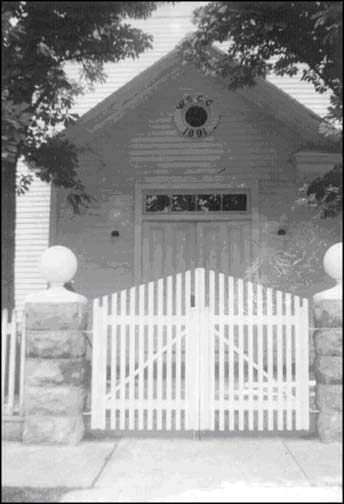
Elders George W. Able and John Pirkey held a meeting August 15-20, 1857, resulting in fourteen additions to the church. This I suppose was the first time Brother Able visited the Valley, at least Walnut Springs.
May 25, 1858, William Saunders who was styled a proclaimer of the gospel was present at a church meeting. August 28-37, 1858, a meeting was held by Elder A. B. Walthall, J. J. Lefever, J. Pirkey and Elder Flippo.
Our worthy chairman, Col. E. F. Stickley was received into the fellowship of this congregation the third Lord's Day in September, 1859 having been baptized at a protracted meeting held at Pugh's Run Seminary by Elders J. Pirkey and J. G. Parish.
We pass in awful silence the period form 1859-1866. Those years when the war cloud was brooding over our land, when brother was arrayed against brother, when Virginia's fairest valley was stained with blood and blackened by flame, pausing just long enough to state that on the first Lord's day in August 1864 Brother Benjamin Watson our senior elder was baptized by Elder John Pirkey. The first Lord's day in July 1866 Brother George W. Ogden was baptized by Elder John Pirkey and on the second Lord's Day was received in the fellowship of the church.
The cooperation meeting which was commenced Friday before the first Lord's Day in August 1868 was continued by Elders J. Creathe, J. H. Berry, J. R. Cave, and John Pirkey. It was on Monday during this meeting that Brother Stickley tired to slip out unnoticed and settle some trouble on the outside when Jacob Creath, who was preaching, saw him, and hollowed at the top of his voice, "Sit down! I was never in such a place before."
On Saturday before the first Lord 's Day in February 1869, Japheth Kellar and B. F. Watson were elected elders thirty years ago. They together with Abram Stickley were ordained August 2 of the same year by Elders John Pirkey and J. A. Cowgill, William Sunders and R. C. Cave. At the same time, J. R. Jenkins, J. T. Ogden, V. Cleaver, and J. W. Stickley were ordained deacons. The second Lord's Day in September 1871, the envelope system of raising money for church an evangelizing purposes was adopted without an opposing vote.
On motion of Levi Stickley seconded by Japheth Kellar, Saturday before the second Lord's day in January 1872, Benjamin F. Watson was appointed by the church to baptize in the absence of an evangelist, or when occasion might require. Benjamin Franklin held a meeting for Walnut Springs congregation beginning about May 3, 1873.
Saturday before the second Lord 's Day in November 1876, G. A. Hinkins and Joseph R. Kellar were elected deacons. Walnut Springs first reported the number of her Sunday School scholars which was sixty in 1876. This may be termed the beginning of the Sunday School report which is now separated from the church report.
During August 1877 a subscription was raised at Walnut Springs to help pay for the Winchester property. $313.50 was subscribed, but $331.92 was paid. The largest contributions were form James Jarrett, $100.00; Abram Stickley, $100.00; E. E. Stickley, $30.00; and G. A. Hinkins, $25.00. Joseph R. Kellar was elected an elder of this congregation and Sarah C. Hinkins and Vizannah Miller, Deaconesses, Saturday before the second Lord's day in November 1878.
January 3, 1880, a resolution was passed to build a baptizing house on the Mine Bank Road near Cedar Creek, but said house was never built.
Brother John Pirkey closed his thirty-year pastorate with Walnut Spring's congregation in the fall of 1883 and Brother C. W. Harvey took up the work and continued for five months. L. D. Kinkaid preached the second Lord 's Day in June and received $3.00. The first Lord's day in October 1884 Brother J. A. Spencer began his labors with Walnut Spring's congregation which continued until April 6, 1890. Philip D. Stickley, George W. Kellar, and M. M. Orndorff were appointed deacons August 1, 1885. P. B. Hall assisted J. A. Spencer in a meeting beginning the first Lord 's Day in November 1885.
The first money raised by Walnut Spring's congregation for foreign missions was $13.00 in 1886; this has been steadily increasing until last year it was over $60.00. This first money giver for Home Missions was in 1887.
August 11, 1890 the old church was torn down. The same day work was begun on the present building, which was occupied for the first time for prayer meeting, October 26, 1890, a month and a half after it was begun, though it was not entirely completed for nearly a year, Brother D. H. Rhodes preached for Walnut Springs from September 1890 to August 1891.
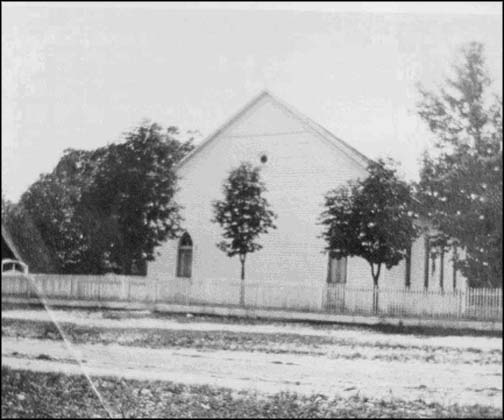
The last convention held at this place was August 6-9, 1891 at which time the present church was dedicated. Brother L. A. Cutler preached the dedicatory sermon. The preachers present were A. R. More, L. A. Cutler, Peter Ainslie, W. S. Hoye, D. J. Dillard, J. D. Hamaker, D. H. Rhodes, George F. McGee, G. W. Ogden, E. B. Bagby, and C. W. Harvey. September 12, 1891, the following trustees were appointed for the church: G. A. Hinkins, J. H. Miller, J. R. Keller, D. R. Stickley, and M. M. Orndorff. At the same time the following deaconesses were appointed: Susan Stickley, Mrs. A. W. Timberlake, and Mrs. M. L. Blanchfield.
J. G. Clemmons preached one year for the church, beginning September 27, 1891. October 4, 1891, Brother Henry Mitchell gave a lecture on India. July 23, 1892, J. W. Beeler, J. E. Timberlake and A. H. Kern were chosen as deacons. September 1892 Brother D. H. Rhodes was employed to preach for one year. February 13, 1892 Abram Stickley died having been a member of the church for thirty-nine years. December 16, Japheth Keller died.
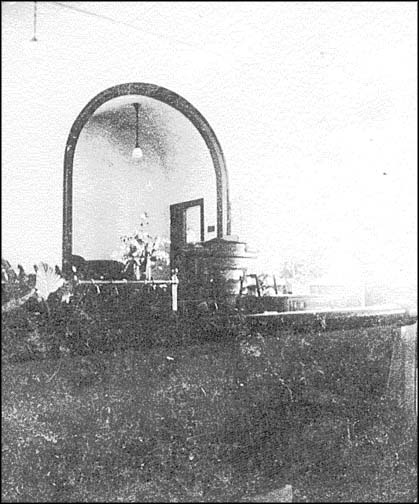
September 3, 1893, Brother Frank Shinall, the blind evangelist, visited Walnut Springs and preached and lectured. October 1, 1893, Brother Isaiah Bauserman was employed to preach one year. He was sick part of the time.
October 26, 1894, W. L. Dudley held a meeting resulting in thirty-two additions. December 16, he began regular work here. August 18, 1894, C. M. Houston preached at nights and represented the interests of the Christian Guide. W. H. Book held a meeting beginning November 18, 1897, resulting in thirty-five additions to the church. C. O. Woodward preached two sermons May 19, 1898. Joseph Watson preached his first sermon June 5, 1898.
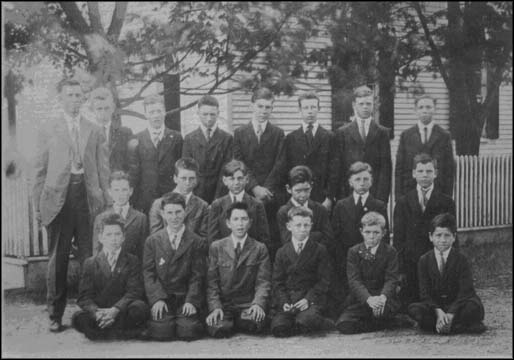
First Row: Orville Miller, Guy Pingley, Kenneth Miller, Harry Lichliter, Leslie Coffelt, Lester Miller. Second Row: Maynard Edmonson, Nelvin Hall, Cecil Keller, Douglas Hausenfluck, Floyd Dodson, Victor Miller. Third row: W. D. Hall, Bernard Hodson, Hugh Racey, Harry Coffelt, Kirby Miller, Maynard Lichliter, Ellsworth Keller, Norman Coffelt.
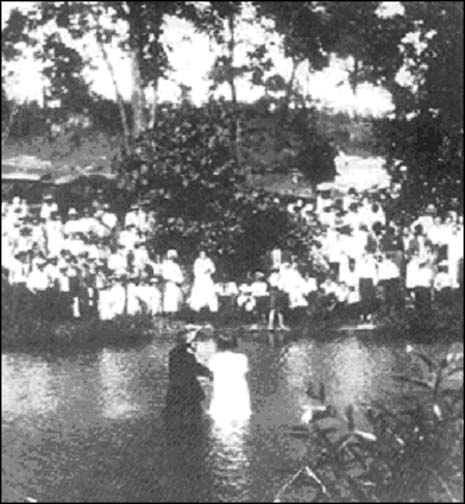
Walnut Springs Church Burns
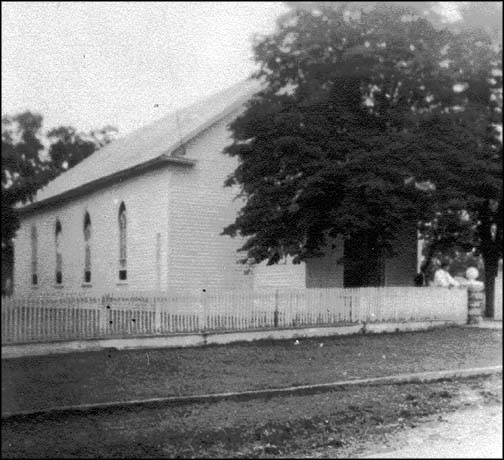
The congregation of the Walnut Springs Christian church, of Shenandoah County, had a very sad experience Sunday morning, December 23, at 10:00 A.M. Just as people were gathering for Bible school the church building caught on fire and burned to the ground in a very short time.
The furnace became overheated in the absence of the janitor. The Strasburg fire department responded at once but could do very little as there was no water of any amount nearby. The members and people of the community were soon on the scene and all the furnishings of the auditorium were taken out, including the pews. All the communion trays and many other things which were in the two rear rooms burned.
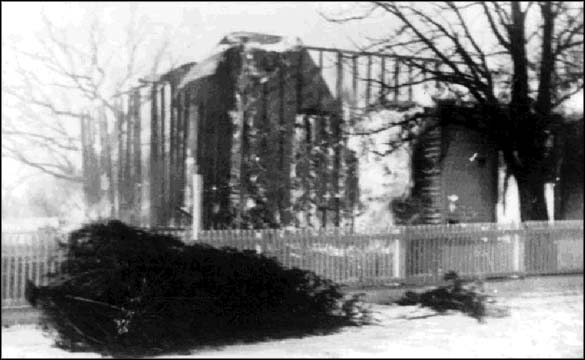
It was indeed a sad sight to stand there helpless and see one of the nicest rural churches in that section burn to the ground, especially when the congregation had just spent about $2,000 to remodel and improve the building in 1942. It was built in 1891 and has had a strong and active membership through the years. This is one of the oldest churches in the Valley of the Disciples of Christ and possibly in the state, having been organized about 1830. A fair amount of insurance was carried on the building which will be paid. The Valley Convention was held with this church in August and many people attended that had not been there for quite awhile and had not seen the building since it had been remodeled. It was appreciated by all.
There was to have been preaching on this Sunday. The pastor, S.J. Goode, who had served the church for six years, arrived just as the building was in full blaze. On the second Sunday in December eight people made confession at the morning service and were baptized that afternoon. These had come to unite with the church the morning of the fire. After the building burned a number of the members met in the schoolhouse nearby and the pastor received six of these into fellowship.
Walnut Springs Rebuilds
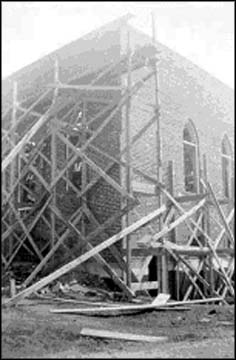
The cornerstone for the new brick church was laid on a beautiful autumn afternoon, November 24, 1946. Within the year, services were being held in the basement. A dedication service was observed June 1948, leaving only the Sunday School rooms in the rear unfinished. On June 17, 1956, these facilities were finished and the church was dedicated to help carry out our Lord's commission.
In 1965, the necessity for additional Sunday School Classrooms was realized. On October 21, 1965, the foundation was laid for the new wing. These rooms were used for the first time on Sunday, September 4, 1966 and dedicated a month later during the afternoon services on Homecoming Day. It was during Homecoming Services, October 13, 1968, a note- burning service was conducted, canceling the indebtedness of this addition.
Only two ministers have ever returned to service as minister and leader of the Congregation, namely, Rev. Daniel Rhodes and Rev. Melvin A. Bobbitt.
Walnut Springs Congregation has not always had a musical instrument within its walls. Prior to 1899 one was thought to be anti-scriptural. However, one was used during the sessions of the Jubilee District Convention in 1899, then had to be removed. It is known that an organ was being used sometime between 1913 and 1920. This instrument was sold to the Community League for $15.00. Two Sunday School classes were given permission to purchase the first piano in 1923. The first electric organ was a Baldwin dedicated January 1959 at a cost of $1,200.00. The Thomas organ in use today was dedicated in 1972. Today, besides the organ there are three pianos in use at various times, besides the Chimes - a memorial gift.
It is interesting to note that only four women have served as organists. The earliest remembered are Mrs. M. Allen Stickley, deceased, and Miss Mae Hausenfluck. Mrs. Mildred Loving served for the longest time (1929- 1964) and our present organist, Mrs. Zelda Keller, has been serving since 1964. Several others have served as assistants down through the years.
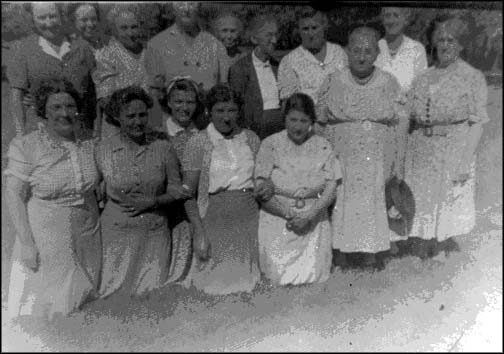
The first work of the women of Walnut Springs was in connection with the Christian Women's Board of Missions, a national organization. Later, for local needs a Ladies Aid Society was formed and continued until 1952 when the Missionary Society and the Ladies Aid were combined to form what the women of the Church are today - The Christian Women's Fellowship or otherwise "The C.W.F.".
In the past the women of the church have sewed, crocheted, had bake sales, window sales, various socials, yard parties, dinners, etc. to raise money for different projects. The largest was when the brick building in which we are meeting today and its annex were built. Today, although few in number, contributions to the Church Finance Council and other outreach projects continue.
The young people have been active, too. Along the way a Mission Band was organized for the children. In 1893 the first Christian Endeavor Society of the Valley among the Disciples was organized at Walnut Springs - to die - revive again - then, to die again. In the late "fifties" the Christian Youth Fellowship of C.Y. F. for the teenage group was organized. Bible study, games and recreation were the work of these groups. Later in the mid sixties came the organization of Chi Rho for the younger children.
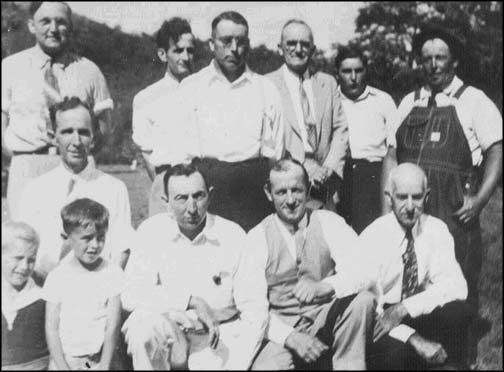
The men of the church have played a very important role, also. They have been faithful in sharing their time and talents in the Lord's work by filling the various offices of leadership within the church. They, too, had a large part in financing the different building projects. Although not locally organized as the C.M.F. or Christian Men's Fellowship, our members do attend the District Christian Men's Fellowship and participate in the District projects. These meetings are held once a quarter with a dinner and program. Twice in this year the attendance almost reached one hundred citizens.
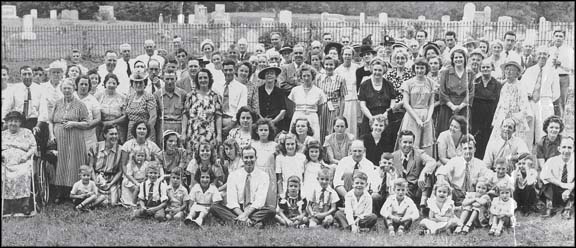
Known Persons pictured: Niles Elliott, Gertie Pangle, Ricky Beeler, Elsie Himelright, Hazel Himelright, Billy Himelright, Glen Himelright, Ruby Himelright, Elsie Shumate, Nancy Helsley, Betty Keller, Harvey Powell, Sally Loving, Katherine Stickley, Jane Mowery, Ina Grove, Jenny Mowery, Philip Loving, Margirette Helsley, Valley Helsley, Gilbert Beeler, Skeeter Stickley, Gene Beeler, Billy Shumate, Mrs. Hargrove, Rev Lee Hargrove, Maxine Stickley, Mildred Loving, Edgar Loving, Cynthia Coffelt, Connely Coffelt, Edward Boyer, Irving Pingley, Alfred Lake, Kitty Loving, Marvin Loving, Francis Miller, Ray Robinson, Lester Miller, Lack Pangle, Garland Elliott, Lillie Good, Mattie Pingley, Katherine Lineburg, Clinton Mowery, Mildred Boyer, Phyllis Minter, Anna Pangle, Tilden Mowery, S. Ed Stickley, Mrs. Minter, Bucky Brill, Turner Stickley, Joe Himelright, William Shumate, Aubrey Pingley, Thurman Elliott, Ernest Good, Mrs. Jim Saum, Lesta Beeler, Nelson Putman, Richard McDonald, Mildred Coffelt Good, Jim Saum, Harry Coffelt, Stella Keller, Effie Coffelt, Hollis Coffelt, Bill Lineburg, Bet Boyer, Norman Coffelt, Maude Coffelt, Annette Coffelt, Mary Crabill, Hollis Coffelt, Ann Crabill, Luna Lowery, Iona Grove, Annie Lineburg, Mrs. Sine, Mr. Sine, Mary Mowery, Stan Boyer, Bracie Good, Stella Stickley, Verge Mowery, Ann Powell, Hattie Stickley, Jerry Hamman, Pete Ogdon, Daisy Miller
Photos and information courtesy Monty Loving.